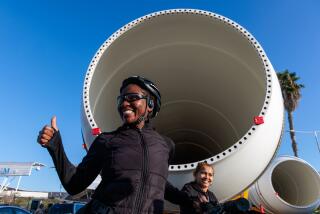U.S., Russian Ships Rendezvous in Space : Shuttle: Discovery, Mir dance a celestial ballet at 18,000 m.p.h.
- Share via
HOUSTON — Two hulking spaceships, hurtling through the darkness at 18,000 m.p.h., treated the world below to a spectacular celestial ballet on Monday as the shuttle Discovery pulled to within a wing’s length of the Russian space station Mir.
With the blue, cloud-shrouded Earth looming in the distance, the two crews launched a historic new era in international spaceflight, highlighted by dramatic video footage of the spacecraft as they drew close enough to exchange elated waves and smiles through the cockpit windows.
“We are bringing our spaceships closer together; we are bringing our nations closer together,” Discovery’s commander, James Wetherbee, said after he maneuvered the 100-ton shuttle to within 37 feet of Mir. “The next time we approach, we will shake your hand and together we will lead our worlds into the next millennium.”
After Wetherbee repeated his message in Russian, the Mir commander, Alexander Viktorenko, replied that the nine members of both crews were involved in the “greatest profession God could give anyone.” The experience, Viktorenko said, was “almost like a fairy tale, almost too good to be true.”
The rendezvous, which marked the first outer-space meeting between the former Cold War rivals since the 1975 Apollo-Soyuz mission, was designed as a dress rehearsal for a series of seven shuttle-to-station dockings scheduled to begin in June. Those dockings are intended to merge the space programs of the two countries by late 1997, enabling the United States and Russia to lead Europe, Japan and Canada in the assembly of a $40-billion, global space station.
Despite continued debate over how such a program would be funded, an ebullient President Clinton called to congratulate the Discovery crew--noting that pilot Eileen Collins was the first woman to hold that position on a shuttle flight and that payload commander Bernard Harris Jr. will become the first African American to walk in space.
“I think people all over our country and all over the world . . . will be seeing you today and saying: ‘You know, this is something worth doing,’ ” said Clinton, who chuckled with delight as the shuttle’s microphone floated back and forth between crew members in the zero-gravity chamber.
Monday’s feat required some of the most precise maneuvering in the history of the shuttle program, which began 14 years ago and is now in its 67th mission. When Discovery lifted off from Kennedy Space Center in Florida on Thursday, the ship had only a five-minute window of opportunity to align itself with the 9-year-old Russian outpost, which has now completed 51,263 orbits of the Earth.
As the shuttle neared to within 2,000 feet of Mir, Wetherbee took manual control of the craft, synchronizing it with Mir’s velocity vector, or “V-Bar,” an imaginary line drawn along the station’s direction of travel. Using steering jets, Wetherbee then slowly drew his ship closer to Mir, lingering for about 10 minutes in the 37-foot to 44-foot vicinity.
“Unbelievable,” said Wetherbee, as cameras mounted on both Mir and Discovery beamed back images of the two craft, which seemed to glide effortlessly in formation, but which in fact were speeding 245 miles above the Pacific Ocean.
“That was a pretty spectacular sight,” said Robert (Hoot) Gipson, who will command this summer’s docking mission between the Atlantis shuttle and Mir. “There are many warm fuzzies that I think we can derive out of today’s activities.”
The operation won high marks for Discovery’s radar and navigational sensors, which officials feared might be thrown off when the ship drew close to the angular Russian station. National Aeronautics and Space Administration administrators said Discovery was never more than four degrees off its mark, maintaining virtually perfect alignment with Mir even as the two spaceships pitched and rolled.
Until Monday morning, such a close encounter appeared to be in doubt, as Discovery continued spouting fuel from a leaky steering thruster. The leak was detected shortly after the shuttle reached orbit on Friday, spewing nitrogen tetroxide, which turns into ice when it encounters the vacuum of space. A second leak was detected Saturday on another jet, but it had stopped several hours later.
Russian space officials expressed concern that the crystallized gas could damage sensitive optical equipment on the Soyuz craft docked at Mir. Although NASA experts insisted that the toxic propellant would evaporate harmlessly, Russian officials wanted Discovery to remain at least 400 feet from their station.
But after many long-distance calls and faxes, NASA agreed to seal off the fuel line to the leaking jet and Russian officials agreed to proceed with the rendezvous.
More to Read
Sign up for Essential California
The most important California stories and recommendations in your inbox every morning.
You may occasionally receive promotional content from the Los Angeles Times.













